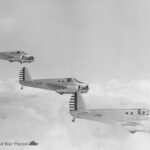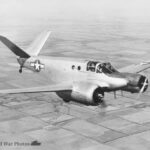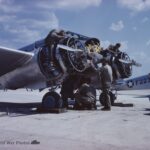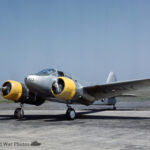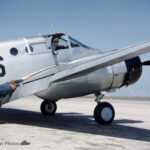Beech AT-10 41-1743 41-1739 2
Beech AT-10- 41-1743 41-1739
Beechcraft AT-10 Wichita
Beechcraft AT-10 flight
Beechcraft AT-10 factory
Beechcraft AT-10 42-2328
Beechcraft AT-10 41-27233, 41-27235 41-23237
AT-10 41-27233, 41-27235
AT-10 V-Tail 42-2272
AT-10 V-Tail
AT-10 V-Tail
AT-10 Wichita F223
AT-10 206
AT-10 206
AT-10 103
AT-10
The Beechcraft AT-10, also known as the Model 25, was an advanced twin-engine training monoplane designed in 1941 at the request of Air Corps officials. Its primary purpose was to serve as the initial step in training pilots to operate twin-engined aircraft. A crucial aspect of its design was to create an airframe predominantly from nonstrategic material, specifically wood, to conserve metals for combat aircraft during wartime. The Beech Company foresaw the difficulties a shortage of light metals might present and planned from the outset to use wood to maximize sub-contracting. Another key specification was the ease and speed of large-scale manufacture. Although the Model 25 had a similar layout to the Model 18, it was an entirely new aircraft.
The AT-10’s airframe was built entirely of plywood, making it an all-wood aircraft, except for the cowlings and cockpit enclosure. The design avoided double-curvature sections and hot-molding processes for forming wooden parts. This simplification was vital, allowing furniture manufacturers and similar wood-working organizations to undertake the building of major sub-assemblies, with an impressive 85 percent of these parts built by sub-contractors. An interesting innovation in its construction was the use of wooden petrol tanks, which were lined with a special synthetic rubber unaffected by the fuel. The aircraft was fitted with two Lycoming R-680-9 radial air-cooled engines, specified as 280 h.p, driving two-bladed constant-speed airscrews or two-blade Hamilton Standard propellers. The wing featured a 6° dihedral and 3°43’35” incidence at the roots, retaining a NACA 23019 Mod aerofoil section at the root. The cockpit enclosure was fitted with a sliding canopy and provided accommodation for two pilots seated side-by-side. It was equipped with dual controls and a full instrument panel, including an automatic pilot.
The AT-10 was the first all-wood aircraft designed by the Beech Company and the first all-wood type to be accepted as an advanced trainer by the U.S. Army. Production totaled 2,371 aircraft, with principal production and assembly undertaken by the Beech Aircraft Corporation and the Globe Aircraft Corporation; most aircraft were produced by Globe. All contracts for the AT-10 ceased in 1944. During the war, it was primarily used in advanced training schools, and it is estimated that about half of the Army’s multi-engine pilots received their transitional training flying AT-10s. After the war, a limited number were sold to the civil market, but most did not operate for long due to their wooden structure. In December 1945, one AT-10 (s/n 42-2272) was experimentally fitted with a Vee, or “Butterfly,” tail-unit to gather engineering data on its flight characteristics. This experiment confirmed that the V-tail arrangement significantly reduced weight and aerodynamic drag without an appreciable drop-off in handling characteristics. Currently, only two AT-10-GFs are known to have survived (s/ns 42-35143 and 42-35180), and they are owned by the US Air Force Museum in Dayton, Ohio.
In terms of specifications, the AT-10 had a span of 44 ft. (13.4 m) or 44ft (13.41m), a length of 34 ft. 4 in. (10.4 m) or 34ft 4in (10.46m), and a height of 10ft 4in (3.15m). The wing area was 298 sq. ft. (27.68 sq. in.) or 297.86sq ft (27.67sq m). Its empty weight was 4,750 lbs. (2,156 kg) or 4,757lb (2,155kg), with a loaded weight of 6,130 lbs. (2,783 kg) or a gross weight of 6,465lb (2,928kg). Wing loading was 21.70lb/sq ft (105kg/sq m) and power loading was 10.95lb/hp (4.96kg/hp). Performance included a maximum speed of 198 m.p.h. (317 km.h.) or 200mph (320km/h) at 4,900ft (1,500m), a cruising speed at 75% power of 168mph (270km/h), and a landing speed of 80 m.p.h. (128 km.h.). It could climb to 10,000 ft. (3,050 m.) in 12.7 minutes, with a rate of climb of 1,150ft/min (350m/min) at sea level. Its service ceiling was 16,900 ft. (5,155 m.) or 19,700ft (6,000m), and it had a range of 770 miles (1,232 km.) at 177 m.p.h. (283 km.h.) or 770 miles (1,240km).
